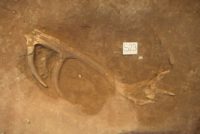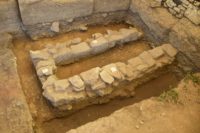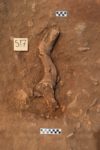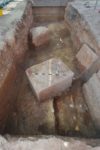 An excavation at the ancient Greek site of Selinus (modern-day Selinunte) in western Sicily has unearthed ancient votive sacrifices of bull horns and antlers. This is the first evidence of bull sacrifice discovered in Selinus whose acropolis is peppered with temples ranging in date from the earliest years of the city’s founding in the 7th century B.C. until its conquest by Carthage in the 4th century B.C.
An excavation at the ancient Greek site of Selinus (modern-day Selinunte) in western Sicily has unearthed ancient votive sacrifices of bull horns and antlers. This is the first evidence of bull sacrifice discovered in Selinus whose acropolis is peppered with temples ranging in date from the earliest years of the city’s founding in the 7th century B.C. until its conquest by Carthage in the 4th century B.C.
An international team of archaeologists and students from New York University and University of Milan has been excavating the temple precinct for 13 seasons. This year’s dig expanded on three trenches along the sides of Temple R and Temple C. Built in the early and late-6th century B.C. respectively, R and C are among the oldest temples at the site, and the excavation focused on exploring the most ancient phases of the sanctuary when the temples were constructed.
 On the east side of Temple R, the archaeological mission unearthed the remains of the western wall of a cult structure with limestone foundations and a crude raised brick platform that dates to the last quarter of the 7th century B.C., predating construction of R. The square structure was approximately 15 feet long and included had two shrines. The discovery a votive deposit of red deer antler (Cervus Elaphus) just outside its perimeter indicates the building had a religious purpose. It appears to be the oldest cult building in the urban sanctuary of Selinunte. It was deliberately but carefully demolished when Temple R was built.
On the east side of Temple R, the archaeological mission unearthed the remains of the western wall of a cult structure with limestone foundations and a crude raised brick platform that dates to the last quarter of the 7th century B.C., predating construction of R. The square structure was approximately 15 feet long and included had two shrines. The discovery a votive deposit of red deer antler (Cervus Elaphus) just outside its perimeter indicates the building had a religious purpose. It appears to be the oldest cult building in the urban sanctuary of Selinunte. It was deliberately but carefully demolished when Temple R was built.
 The excavation also revealed initial phases of construction of R, including two post holes, used to lift the stone blocks and a hollow libation altar in excellent condition. Most notably, the team unearthed a votive deposit of two bull horns (Bos Taurus) from a large adult animal. This is the first archaeological evidence for the sacrifice of bulls in the great urban sanctuary of Selinunte.
The excavation also revealed initial phases of construction of R, including two post holes, used to lift the stone blocks and a hollow libation altar in excellent condition. Most notably, the team unearthed a votive deposit of two bull horns (Bos Taurus) from a large adult animal. This is the first archaeological evidence for the sacrifice of bulls in the great urban sanctuary of Selinunte.
 The trench between Temple R and Temple C has revealed the foundations of C, exposing how the slope of this side of the acropolis was artificially construction to support the monumental temple. This layers are well preserved and shed new light on how the temple was built, particularly the construction of the foundations and crepidoma (the platform on which the temple superstructure was built). Here archaeologists found additional votive deposits of exceptional quality made of gold, silver, ivory and one Egyptian faience falcon.
The trench between Temple R and Temple C has revealed the foundations of C, exposing how the slope of this side of the acropolis was artificially construction to support the monumental temple. This layers are well preserved and shed new light on how the temple was built, particularly the construction of the foundations and crepidoma (the platform on which the temple superstructure was built). Here archaeologists found additional votive deposits of exceptional quality made of gold, silver, ivory and one Egyptian faience falcon.